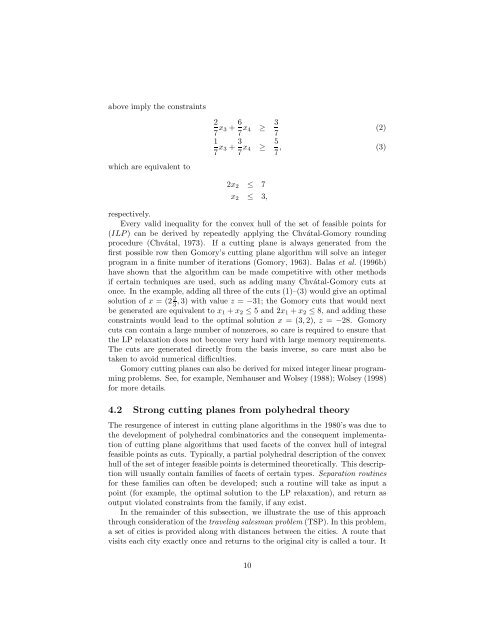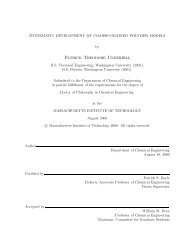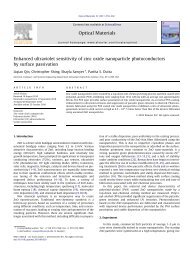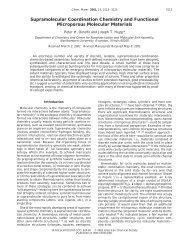Branch-and-Cut Algorithms for Combinatorial Optimization ...
Branch-and-Cut Algorithms for Combinatorial Optimization ...
Branch-and-Cut Algorithms for Combinatorial Optimization ...
You also want an ePaper? Increase the reach of your titles
YUMPU automatically turns print PDFs into web optimized ePapers that Google loves.
above imply the constraints<br />
which are equivalent to<br />
2<br />
7 x3 + 6<br />
7 x4 ≥ 3<br />
7<br />
(2)<br />
1<br />
7 x3 + 3<br />
7 x4 ≥ 5<br />
,<br />
7<br />
(3)<br />
2x2 ≤ 7<br />
x2 ≤ 3,<br />
respectively.<br />
Every valid inequality <strong>for</strong> the convex hull of the set of feasible points <strong>for</strong><br />
(ILP) can be derived by repeatedly applying the Chvátal-Gomory rounding<br />
procedure (Chvátal, 1973). If a cutting plane is always generated from the<br />
first possible row then Gomory’s cutting plane algorithm will solve an integer<br />
program in a finite number of iterations (Gomory, 1963). Balas et al. (1996b)<br />
have shown that the algorithm can be made competitive with other methods<br />
if certain techniques are used, such as adding many Chvátal-Gomory cuts at<br />
once. In the example, adding all three of the cuts (1)–(3) would give an optimal<br />
solution of x =(22, 3) with value z = −31; the Gomory cuts that would next<br />
3<br />
be generated are equivalent to x1 + x2 ≤ 5<strong>and</strong>2x1 + x2 ≤ 8, <strong>and</strong> adding these<br />
constraints would lead to the optimal solution x =(3, 2), z = −28. Gomory<br />
cuts can contain a large number of nonzeroes, so care is required to ensure that<br />
the LP relaxation does not become very hard with large memory requirements.<br />
The cuts are generated directly from the basis inverse, so care must also be<br />
taken to avoid numerical difficulties.<br />
Gomory cutting planes can also be derived <strong>for</strong> mixed integer linear programming<br />
problems. See, <strong>for</strong> example, Nemhauser <strong>and</strong> Wolsey (1988); Wolsey (1998)<br />
<strong>for</strong> more details.<br />
4.2 Strong cutting planes from polyhedral theory<br />
The resurgence of interest in cutting plane algorithms in the 1980’s was due to<br />
the development of polyhedral combinatorics <strong>and</strong> the consequent implementation<br />
of cutting plane algorithms that used facets of the convex hull of integral<br />
feasible points as cuts. Typically, a partial polyhedral description of the convex<br />
hull of the set of integer feasible points is determined theoretically. This description<br />
will usually contain families of facets of certain types. Separation routines<br />
<strong>for</strong> these families can often be developed; such a routine will take as input a<br />
point (<strong>for</strong> example, the optimal solution to the LP relaxation), <strong>and</strong> return as<br />
output violated constraints from the family, if any exist.<br />
In the remainder of this subsection, we illustrate the use of this approach<br />
through consideration of the traveling salesman problem (TSP). In this problem,<br />
a set of cities is provided along with distances between the cities. A route that<br />
visits each city exactly once <strong>and</strong> returns to the original city is called a tour. It<br />
10







